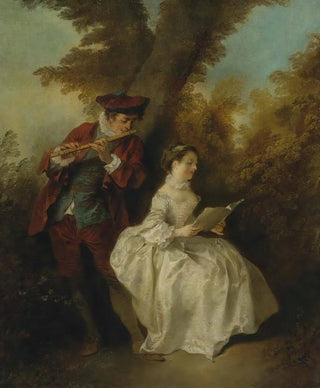Art print | Le Duo un jeune homme jouant de la flûte et une jeune femme chantant dans un paysage - Nicolas Lancret Source: Reproduction | Le Duo un jeune homme jouant de la flûte et une jeune femme chantant dans un paysage - Nicolas Lancret


View from behind

Frame (optional)
The artwork titled "The Duo, a young man playing the flute and a young woman singing in a landscape" by Nicolas Lancret is a true ode to beauty and harmony. Painted in the 18th century, this canvas depicts a bucolic scene where music and nature intertwine, creating an atmosphere of serenity and pleasure. The characters, delicately rendered, seem to flourish in a world that is both ideal and timeless. This piece, emblematic of the Rococo style, invites the viewer to immerse themselves in a universe where lightness and elegance reign supreme. The depiction of music, an universal art par excellence, is here elevated by Lancret's talent, capturing the fleeting moment of shared joy.
Style and uniqueness of the work
Nicolas Lancret's style is distinguished by its finesse and lightness. In "The Duo," pastel colors, soft and luminous, dominate the composition, creating a calming and dreamlike atmosphere. The characters, dressed in delicate costumes, are portrayed with great attention to detail, while their expressions reflect a deep complicity. The posture of the young man, leaning towards the young woman, and her graceful gesture, as if singing with passion, reinforce the idea of a communion between the two artists. The landscape surrounding them, with its green trees and clear sky, serves as a backdrop to this idyllic scene and contributes to the overall harmony of the work. Lancret thus succeeds in creating a painting that, beyond its formal beauty, evokes universal emotions related to love, art, and nature.
The artist and his influence
Nicolas Lancret, an emblematic figure of the Rococo movement, left his mark on his era with refined and sensual works. Trained under great masters, he developed a personal style that skillfully combines the lightness of forms with deep sensitivity. His art is characterized by meticulous attention to detail and the depiction of everyday life, often imbued with a certain

Matte finish

View from behind

Frame (optional)
The artwork titled "The Duo, a young man playing the flute and a young woman singing in a landscape" by Nicolas Lancret is a true ode to beauty and harmony. Painted in the 18th century, this canvas depicts a bucolic scene where music and nature intertwine, creating an atmosphere of serenity and pleasure. The characters, delicately rendered, seem to flourish in a world that is both ideal and timeless. This piece, emblematic of the Rococo style, invites the viewer to immerse themselves in a universe where lightness and elegance reign supreme. The depiction of music, an universal art par excellence, is here elevated by Lancret's talent, capturing the fleeting moment of shared joy.
Style and uniqueness of the work
Nicolas Lancret's style is distinguished by its finesse and lightness. In "The Duo," pastel colors, soft and luminous, dominate the composition, creating a calming and dreamlike atmosphere. The characters, dressed in delicate costumes, are portrayed with great attention to detail, while their expressions reflect a deep complicity. The posture of the young man, leaning towards the young woman, and her graceful gesture, as if singing with passion, reinforce the idea of a communion between the two artists. The landscape surrounding them, with its green trees and clear sky, serves as a backdrop to this idyllic scene and contributes to the overall harmony of the work. Lancret thus succeeds in creating a painting that, beyond its formal beauty, evokes universal emotions related to love, art, and nature.
The artist and his influence
Nicolas Lancret, an emblematic figure of the Rococo movement, left his mark on his era with refined and sensual works. Trained under great masters, he developed a personal style that skillfully combines the lightness of forms with deep sensitivity. His art is characterized by meticulous attention to detail and the depiction of everyday life, often imbued with a certain






